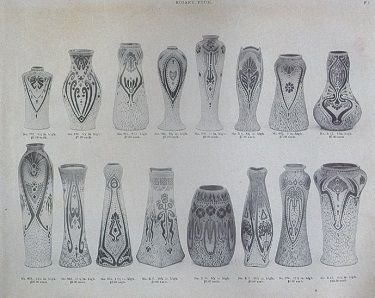
Collectors Guide to Roseville Pottery Fudji, 1906-1907
What is Fudji?
Fudji is a line of art pottery produced from 1906 through 1907 by the Roseville Pottery Company in Zanesville, Ohio.
Who designed Fudji?
The Fudji line was designed by Gazo Foudji, a Japanese artist who migrated to Zanesville and worked as a designer for the Roseville Pottery Company.
In 1905, The Roseville Pottery Company welcomed a new talented designer into their growing endeavor. Gazo Foudji was a Japanese-born artist, and as soon as he arrived he began experimenting. His experiments were mostly hand-carved, partially glazed, and colored with enamel decorations. These pieces often carry a cursive ink-stamp on the base "Fujiyama". The forms used were usually standard Rozane shapes, and many of them appear to lay the groundwork for the Woodland lines. These pieces should not be confused with the actual Fudji line.
When was Fudji made?
The Fudji line was produced in 1906 and 1907.
A single surviving catalog page from 1906 indicated 16 standard shapes and design. Several other forms have been discovered, all of which carry the Rozane Ware wafer. This indicates they were likely released after this known catalog page.
The designs are often described as both japanesque and art nouveau, the predominant theme being a webbed design on the lower portion. The webbed design often appears like grass or stones and can be any of several colors. The main features tend toward curving natural art nouveau lines and framing, punctuated by dots, sprigs, and other repeating flourishes. The execution style is sgraffito, with rich enamel colors applied over a bisque body. The interior is glazed in a solid color, usually complimentary to the colors of the main design. With few exceptions, the subjects are abstract floral themes. Several of the forms were reused for the Rozane Woodland line, and some can also be found as canvases for Rozane Royal.
Since the decorations were applied individually and manually by artists, there is some basic variation between pieces. Occasionally pieces are found missing some parts of their standard designs, and some color variation has been found. That said, it appears each shape had a standard design associated with it, creating a limited number of designs for a complete collection.
Below is a compendium of the known shapes and designs. The first 16 from the 1906 catalog page are shown first in groups of three, followed by larger images of the uncatalogued pieces.
-

Fudji Catalog Page
-

Fudji Shapes 961, 973, R5
-

Fudji Shapes 972, R12, 893
-

Fudji Shapes 975, 892, 971
-

Fudji Shapes 982, 970, R6
-

Fudji Shapes R14, R3, 974
-

Fudji Shape R15
-

Unknown shape, 7 inches, marked with Rozane Ware Wafer
-

Unknown shape, 8 inches, marked with Rozane Ware Wafer
-

Unknown shape, 11 inches, marked with Rozane Ware Wafer
If you have more questions, we are certain you will find the answers in the following books. Each of these books is highly recommended for collectors of Roseville Pottery. The owners of this website may receive compensation for qualified sales of the books.




